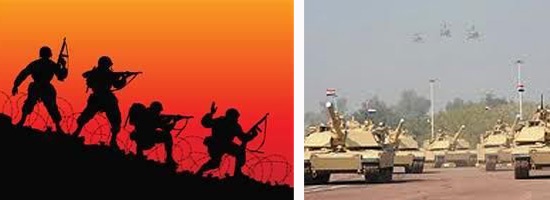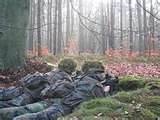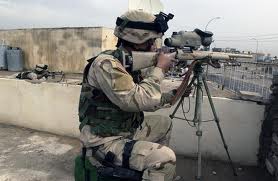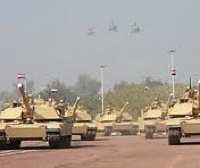Tactics 101 073: Light-Heavy Operations
Light-Heavy Operations

"Figure out how to do things so that you can get the
maximum effect and the least bloodshed."

Sun Tzu

The light infantry battalion was ordered to attack an enemy motorized rifle company consisting of 10 BMP’s, 3 T72 tanks and 70 plus infantrymen. Although they were defending in a relatively densely wooded area, their position was dug in astride an open area that over-watched a 4-way road intersection. The division needed to control the intersection to continue the offensive. The task of the light battalion was to control the intersection. Their purpose was to facilitate the continuation of the division attack.
{default}The enemy was dug in deeply and they were surrounded by a dense and complex system of obstacles. The strongpoint was oriented on dominating the road. The light battalion assigned to destroy the defenders was augmented by the brigade commander. He attached an armor company consisting of 10 M1A1 Abrams Tanks. It was a significant addition of combat power. Of course, it is only combat power if it is utilized and utilized efficiently.
The mission was training; the commander was new; and the location was Fort Benning, Georgia. He was an old fashioned infantryman, who didn’t think he needed tanks to help his ‘light fighters’ execute and accomplish the mission. He planned to leave the tanks in an assembly area behind the line of departure. He designated them as his reserve and would only call on them if he got in trouble. He was sure that call would not be needed.
This didn’t sit well with his evaluator for exercise. We’ll come back to this shortly.
***************************
LAST MONTH
In our last article, we begin our series on the integration of heavy and light forces on the battlefield. The article keyed on the augmentation of a heavy force with a smaller force (Heavy-Light Operations). In our discussion, we addressed the following: 1) Definition of Heavy-Light Operations 2) Why we use heavy-light 3) A concise assessment of heavy forces 4) A concise assessment of light forces 5) When would light forces benefit heavy forces 6) The challenges light forces bring to a heavy force headquarters. In addition to the above, we wove a war story throughout that provided a great example on how the heavy-light mix should be utilized.
THIS MONTH
This month’s article will shift the emphasis and focus on Light-Heavy Operations. In this relationship, a smaller unit of mechanized vehicles (tanks and/or infantry fighting vehicles) augments a larger light infantry unit. Our discussion will focus on the following: 1) Why light-heavy operations. 2) What heavy forces bring to light forces. 3) What are the challenges of heavy forces. 4) The safety concerns of heavy forces working with light forces. 5) Planning considerations of heavy forces. We also conclude the article with the rest of the story from the attack we highlighted above. LET’S MOVE OUT!
Light-Heavy Operations
Light-Heavy operations are missions conducted by a task force or team consisting of infantry, mechanized infantry, motorized, or armored forces under a light infantry headquarters. So why put tanks or infantry fighting vehicles (IFV’s) under a light infantry command? The answer is found in the idea that each force has strengths and weaknesses that balance, compliment and mitigate one another. Armor can support infantry by providing accurate long-range fires; day or night, stationary and on the move. They can suppress or destroy enemy vehicles in support of the infantry. They can fix enemy forces as the infantry breaches obstacles or maneuvers to an enemy weak point.
The Elements of Combat Power
The way to determine when, why, and how to mix heavy and light forces is to assess their relative strengths and weaknesses based on the four elements of combat power: maneuver, firepower, protection and leadership. We assessed light and heavy forces in the last article so, this time, we’ll focus on what ‘heavy’ assets bring to the light heavy fight.

Tanks. The most obvious attachment to the light task force is the tank. The M1Abrams tank provides speed and mobility; comes with excellent protection and lethal fires. As history has proven, it is most effective in open terrain with extended fields of fire.
Mobility.
Capabilities. The M1 can move quickly either on or off road. It can cross ditches; ford streams and shallow rivers; and push through small trees, vegetation, and limited obstructions. Tanks move effectively in multiple types of terrain while delivering firepower and shock effect against the enemy.
Limitations. Tanks are noisy—you’re not going to sneak up on anybody in an M1! In cold weather and when thermal night-sights and/or radios are used, tanks must run their engines about 30 minutes every 2 hours to keep the batteries charged. Tanks can only cross bodies of water less than 4 feet deep without bridging. Another significant limitation is that the M1 guzzles fuel! You will find no economy versions of M1. It’s not miles per gallon; it’s gallons per mile!
Firepower.
Capabilities. The M1’s 120mm main gun is accurate and lethal at ranges out to 3 kilometers. The gun is stabilized which allows effective fires even when the tank is moving cross-country. M1 tanks pack a formidable array of machine guns; the tank commander’s 50 cal, the loader’s 7.62-mm coax machine gun and the 7.62-mm machine gun. These provide a high volume of suppressive fires for self-defense and supporting fires for the infantry. The tank’s on board target acquisition system exceeds the capabilities found in a light infantry battalion.
Limitations. The tank’s top, rear, and flank are vulnerable to antitank weapons. The top is also vulnerable to precision-guided artillery or air-delivered munitions. Antitank mines can destroy or disable the M1. Tanks fight with their hatches closed which reduces the crew visibility.
Protection.
Capabilities. M1 armor provides excellent protection. Across the frontal 60-degree arc, the tank is safe from all weapons except heavy antitank missiles or guns and the main gun on enemy tanks. When fighting with the hatches closed, the crew is safe from small-arms fire, artillery (except direct hits), and antipersonnel mines. The tank’s smoke grenade launcher provides rapid concealment from non-thermal observation.
Limitations. Tanks are vulnerable from the flanks, top, and rear to light antitank weapons. The top is vulnerable to precision-guided munitions while antitank mines can disable the vehicle. Again, fighting with hatches closed reduces crew visibility.

Infantry Fighting Vehicle. The M2/M3 Bradley Infantry Fighting Vehicle (IFV or BFV) provides mobility and protection against small arms fire and shrapnel. They deliver excellent firepower. IFV’s operate best on open terrain for mounted maneuver. To best employ IFVs, commanders must consider their limited protection. Each IFV can carry a 9-man squad.
Mobility.
Capabilities. The M2/M3 was designed to partner with the M1 and thus, has mobility similar to the tank. The Bradley has the added capability, not resident in the M1, to swim across large bodies of water, with moderate currents, where entry and exit points are available. They can carry soldiers inside and outside while swimming. (Having swum on a Bradley many times, we can vouch that yes it can swim).

Limitations. Bradley’s use lots of fuel (although obviously less than an M1), and consumption obviously increases during offensive or fast-paced missions. Like tanks, IFVs are noisy and in cold weather or when using thermal night-sights or radios are used, IFV’s must run their engines to keep the batteries charged. The noise, smoke, dust, and heat generated by IFVs make surprise difficult.
Firepower.
Capabilities. The Bradley packs a 25-mm chain gun as its’ main weapon. It also has a TOW missile launcher and a coaxially-mounted machine gun. The chain gun is accurate and lethal against lightly armored vehicles, bunkers, trench lines, and troops out to 2 kilometers. It also has stability which allows for accurate fire on the move. The TOW provides a lethal anti-tank capability able to kill enemy tanks or other point targets out to 3,750 meters. The 7.62-mm coax machine gun provides a high volume of suppressive and supporting fires for the infantry. The stabilized turret, thermal sights, high volume of fire, coupled with a diverse mix of weapons and ammunition (TOW missiles, 25-mm APDS and HEI-T, and 7.62-mm) makes the Bradley an excellent fire support platform in support of an infantry assault. The IFV can acquire targets better than other infantry battalion systems. The thermal sight allows the crew to observe, recon, and control fires and can be used during the day to identify heat sources through light vegetation and other concealment.
Limitations. The Bradley thermal sight, when operated with the vehicle’s engine off, clicks loudly enough to be heard at a good distance from the vehicle. Of course at night, that sound seems to carry forever. Logistical resupply of fuel and ammo may be difficult and usually requires external support not resident within a light infantry unit.
Protection.
Capabilities. The IFV provides good armor protection. When fighting with the hatches closed, the crew is safe from small-arms fire, fragmentation munitions, and anti-personnel mines. The vehicle’s smoke grenade launcher and smoke generator provide rapid concealment from observation from everything, but thermal sights.
Limitations. The IFV is vulnerable from all directions to anti-tank weapons and is especially vulnerable to enemy tanks. Anti-tank mines can destroy or disable the Bradley. When operating with open hatches, the crew is vulnerable to small-arms fire and sniper fire.
The Challenge—Safety.
Infantry leaders need to take safety precautions when operating with armored vehicles. This is especially important for infantry units with little training or experience with armored vehicles. All personnel must know the precautions to take and must remain alert during light-heavy operations.
Tank and Bradley crews are blind to infantry soldiers near their vehicle. This limitation is worse during limited visibility or when the hatches are closed. This causes the crew to focus on the enemy or on potential enemy locations rather than on infantry moving close to the vehicle. Therefore, the infantry soldiers must remain alert and must maintain a safe position relative to the vehicle.
Infantry moving next to armored vehicles will be exposed to fire directed against the vehicles. They will not be able to avoid detection when near the armor. Troops on the ground should maintain enough distance to avoid enemy fires even when they are providing security or close support to them. Likewise, the armor-piercing discarding sabot round fired by the tank main gun and the Bradley 25-mm gun can injure soldiers in close proximity to the vehicle.
M1’s exhaust can reach 1,700 degrees or more. Soldiers behind a tank must be to the side of the exhaust grill and should not move directly behind it. Soldiers riding on the vehicle trade the speed of mounted movement for stealth; you’ll be detected more easily so be careful when ground troops ride and when they walk. Infantry should ride on vehicles only when the risk of enemy contact is low or the need for speed is great.
Don’t ride on the lead vehicle; it’s the most likely one to make contact and can react quicker without soldiers on top. Infantry leaders should ride with the armored leaders. Contingency plans for chance contact and danger areas must be planned and rehearsed since vehicles and soldiers react differently. The infantry should dismount and clear choke points and danger areas with the armor providing suppressive fire and overwatch.
Air guards and sectors of responsibility for observation will be assigned and alert methods must be agreed upon. The infantry will probably spot enemy air sooner than vehicle crews will and they must have a means for alerting them. Infantry must be alert and ready to dismount quickly. In the event of contact, the armored crew reacts to protect their vehicle and the infantry on top are responsible for their own safety. They should rehearse rapid dismount and leaders should consider leaving rucksacks and extra gear on the vehicles while having the soldiers move on more suitable terrain near the vehicles.

Support of Light Infantry.
Light infantry can attack independently and link up afterwards. They can precede armor through an air or airborne insertion or by infiltration. Light infantry may ride on vehicles (see above) to exploit their mobility and armor can use on-board smoke to provide obscuration. Armor can also provide long-range observation and target detection, especially at night. Armor can also help with casualty evacuation and by hauling extra gear and resupply.
Tanks can lead movement, using firepower, mobility, and protection to quickly develop the situation upon making contact. Tanks can also follow the infantry to the objective after lanes through obstacles have been cleared and can lead, or provide suppressive fires for, the assault on the objective. They can also provide protection when the enemy antitank capability is limited and, of course, tanks can be used to destroy enemy armored vehicles—especially tanks.
Never underestimate the psychological impact tanks can have on the enemy. Having been on both sides of this, we can vouch for what the sight of tanks in formation can do to the mind of a soldier. When a soldier sees tanks accompanying infantry (when he is expecting a pure light fight) the pucker factor goes sky high.
Infantry supports armor by clearing or breaching obstacles and marking lanes in minefields to allow the armor to use its speed and mobility. Infantry can destroy, suppress, or neutralize anti-tank weapons and destroy enemy bunkers. They can follow an armored assault closely to protect the rear and flanks of the tanks and can clear the objective or reduce bypassed enemy forces. They can secure or clear choke points such as towns, forests, stream crossings, and narrow defiles and can provide close security at nighttime or in restrictive terrain. Lastly, infantry is always well suited to conduct reconnaissance in support of planned armored maneuver.

PLANNING.
The light infantry staff must study and prepare for light-heavy operations since they are not typically versed in them. An officer from the armored unit should be attached to the light unit headquarters where he can advise and assist in planning and execution. The commander of the armored unit should be asked for his recommendation on how to employ his forces although, the light commander has the final say. The light unit staff must know the abilities, limitations, and requirements of the armored force and must plan for them. Let’s address some of the key planning considerations below in the areas of intelligence, maneuver, combat service support, and command and control.
Intelligence.
- Reconnaissance and surveillance that integrates the heavy force should be developed.
- Commanders should use the light force’s night vision and dismounted movement and the heavy force’s thermal imagery and long-range night vision capabilities.
- The heavy force should be allowed to provide input into reconnaissance planning.
- An excellent counter- recon plan uses the infantry as the screening force that finds the enemy and the armored force to destroy the enemy.

Maneuver.
- Infantry units often conduct operations during limited visibility to gain surprise and reduce vulnerability.
- The difference in mobility between heavy and light units should be taken into account when terrain is assigned.
- The timing for every operation must be planned to avoid leaving either force, especially the light force, exposed.
- The strengths of both heavy and light units should be used to advantage with appropriate tasks assigned, fighting each in a manner that capitalizes on the strengths while minimizing the weaknesses.
- Each force should compensate for the limitations of the other throughout the operation.
- The tactical signature of each should be considered. The heavy force will be more easily detected and, as a result, accompanying infantry maybe targeted even if not detected. If infantry with the heavy force can effectively accomplish the mission from a more secure location, they should do so.
- Armor and infantry can provide mutual support without being co-located.
- The characteristics of heavy forces must be considered to prevent friendly casualties by employing and rehearsing fire control measures.
Combat Service Support.
- Light-heavy operations significantly increase the logistics requirements for the light unit.
- It is preferable if the armored unit brings along a supply specialist to aid the light logistics planners.
- The light unit must ensure that the attached logistics can provide sufficient support to the heavy unit and, if not, must then request additional support from the heavy force’s parent unit.
- The light unit logistics officer must integrate the heavy unit’s logistics support into the light unit’s overall logistical plans. He must also ensure that the heavy unit knows the situation and that all logistical actions are coordinated, to include:
—Routes, locations, and timings to be used for conducting the heavy force re-supply
—Casualty evacuation plan
—Vehicle evacuation plan
Command and Control.
- The heavy force is usually placed under the operational control (OPCON) of the light force because the light force typically cannot logistically sustain the heavy force for very long. The heavy force can be attached for a short time when it brings enough logistical support to sustain itself.
- Both forces must exchange the frequencies and call signs.
- The commander should consider the following when task-organizing a heavy force into the light force:
—Allow the heavy force commander to retain control of most of his unit to use his expertise
—Tanks are most effective when used in mass
—Task organizing should occur at platoon level or above to ensure an effective chain of command and to allow the heavy unit to fight as trained.
—Task organizing tanks and/or Bradleys by section may be the right answer for urban operations. However tanks and Bradleys should not be task organized on an individual basis ever—keep them in pairs; they need a ‘wingman’ to maneuver with mutual support

Complimentary effects—back to Benning.
The battalion commander was a student in the infantry pre-command course. He was firm in his conviction that his battalion of light fighters had no need for a bunch of tankers. His staff, a group of advanced course students headed for company command, was stumped. They had been trained to task organize in order to exploit strengths and mitigate weaknesses. Who would leave 10 Abrams tanks in an assembly area when attacking a dug in enemy company reinforced by mines, wire, artillery and a reserve tank platoon?
The mentor asked the commander for his reasoning. He listed the tanks deficiencies:
—They’re noisy
—They’re road bound
—They’d be blocked by the obstacles
—The plan relies on stealth
The mentor responded:
—They’re noisy—so are the enemies tanks and IFV’s
—They’re road bound—not really, an M1 can push over a tree 12 inches in diameter
—They’d be blocked by the obstacles—they have their own smoke, suppression, and one tank plow per platoon
—The plan relies on stealth—doesn’t a diversion aid stealth; if nothing else, the tanks could stop 2 kilometers from the enemy and pummel them with 120mm fires
The commander didn’t know the tanks main gun range nor did he know about its multiple machine guns and on board smoke. He also had no idea that tank platoons had mine plows. Lastly, he thought off-road movement was impossible. In spite of the new information that had been passed on to him, he attacked without the armor … and won at a cost of 50+% casualties.
The senior evaluator, a full Colonel in the infantry, made him plan a new mission, this time using the tanks.
The infantry companies infiltrated through the woods at nighttime, as before. This time, the tank company launched a diversionary attack up the road and into the obstacles at the intersection. They blanketed the enemy company with 120mm main gun and machinegun fire while blanketing the entire intersection with smoke. The battalion mortars added their fires to the armored assault.
The defenders responded to the tank attack by repositioning towards and calling up their reserve tank platoon. The new plan anticipated the move of reserves. They were waiting for them with a light infantry anti-tank ambush which destroyed one tank and immobilized the other two.
This was the trigger for the light assault from the wood-line to the defenders rear. The enemy company was completely focused on the Abrams tanks at the road and were blindsided by the swarms of infantry. When the enemy armor vehicles tried to move from their forward positions in response to the infantry attack, they were destroyed by the M1’s over-watching from the road. The infantry rapidly over-ran the enemy position while M1’s lifted and shifted their fires away on order from the commander.
Once the objective was secure, the tanks provided an armed escort to the light battalion trains and then provided perimeter security during consolidation and reorganization. The mission took half the time and suffered two-thirds fewer casualties. The evidence was conclusive: the light-heavy team attack was vastly superior to the infantry pure attack. Usually, if your boss gives you additional combat power, he’s doing it for a reason.

*******************************
REVIEW
Tanks and Infantry Fighting Vehicles have operated in support of light infantry since WWI. The US has a long and proud history of such operations however; they are never to be embarked upon lightly and without detailed planning, preparation and rehearsal. Failure to closely adhere to the troop leading procedures when mixing and matching these disparate forces can lead to disaster and unnecessary casualties. We have many different types of forces in order to execute many different types of missions and the ‘teaming ‘of these various forces can be incredibly potent. In fact, to avoid light-heavy or heavy-light operations when the conditions call for it is to miss an opportunity for decisive success.
NEXT MONTH
In our next article, we will begin a series of articles tied to security operations. We will begin the series addressing the basics of security operations. Following this introduction, we will dissect the three primary security operations. These are screen, guard, and cover. As always, we will delve into the planning, preparation, and execution of each of these operations. Security operations set the conditions for a unit’s execution of their primary mission (be it an offense or defense). A poor performance in security operations is a recipe for disaster.

